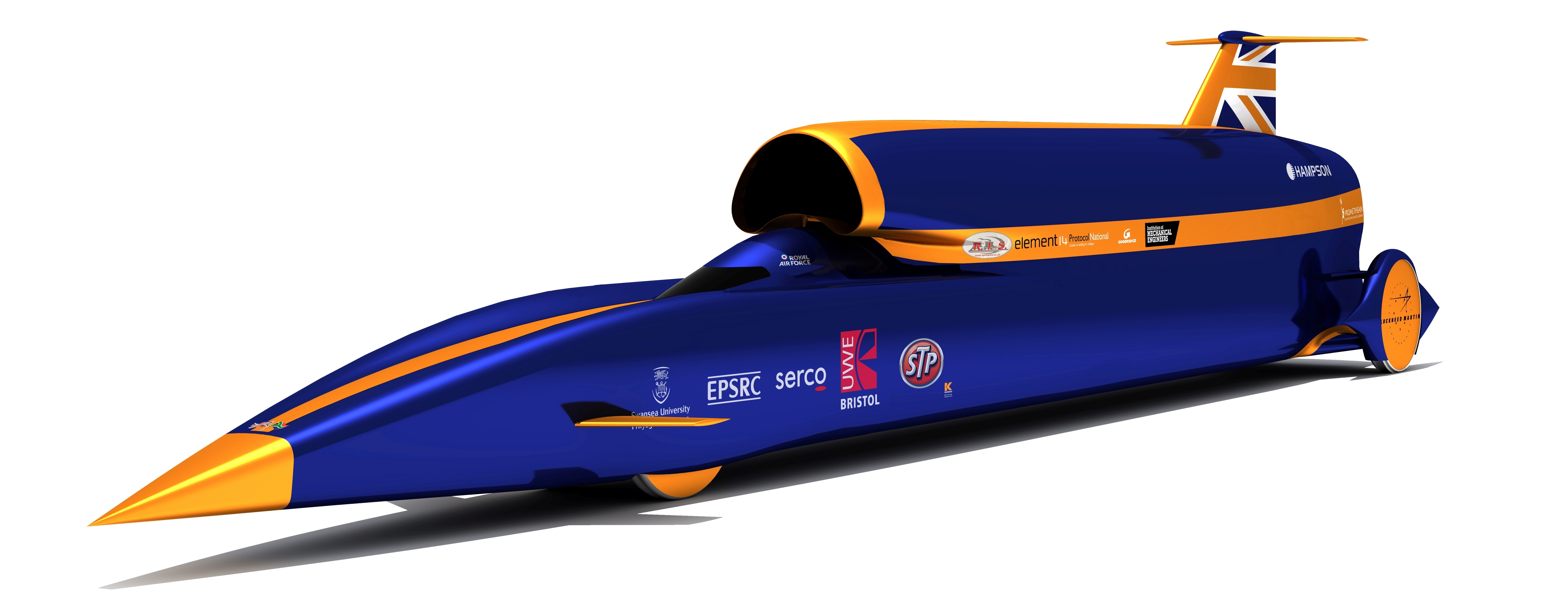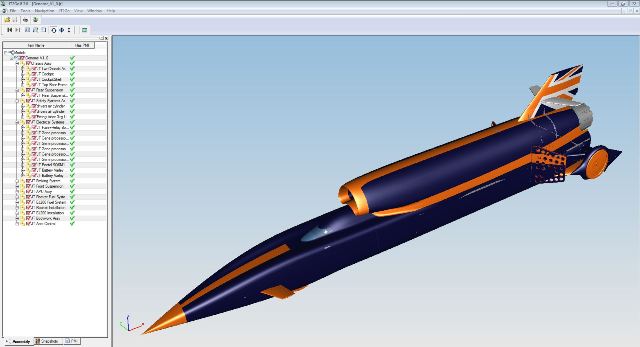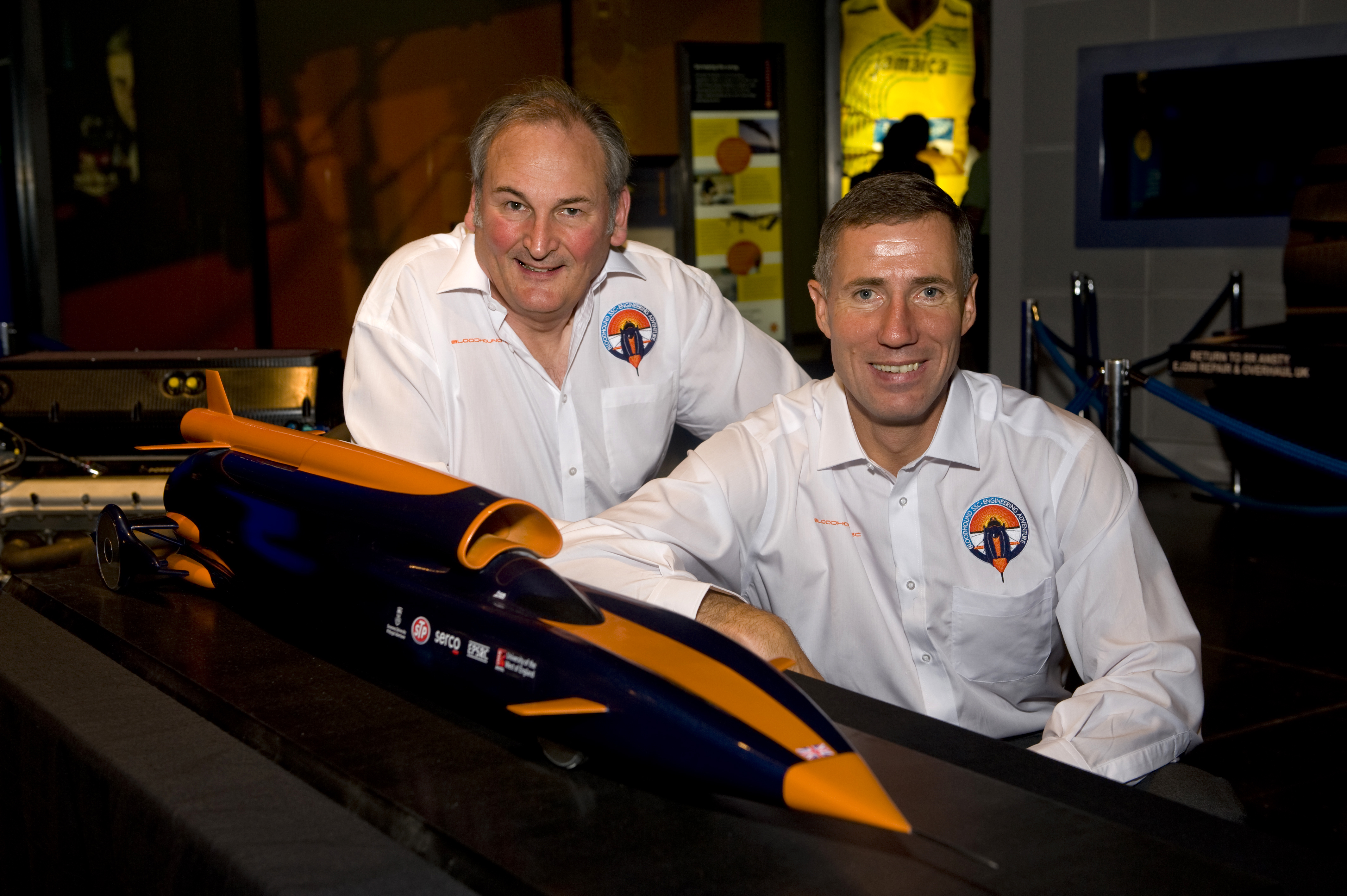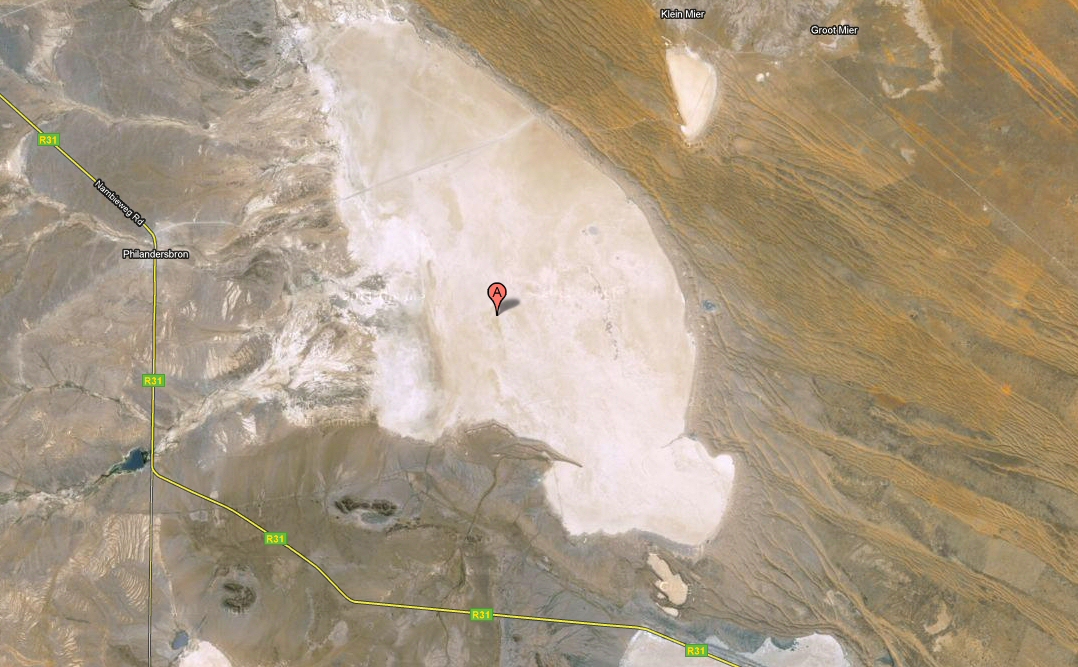The 1,000mph car that can outrun a bullet

It's difficult to imagine exactly how fast 1,000mph is.
But try this; if you were up in the stand at Wembley Stadium, and an object flew into the arena at 1,000mph before exiting at the other end, if you blinked at the wrong moment, in the 300 milliseconds it would take you to close and reopen your eyes, you would completely miss it.
The air is actually so dense at ground level that no supersonic jet fighter in the world is capable of flying as fast as 1,000mph in low altitude. If you were to fire a Magnum 357 handgun after an object travelling at this speed - 232mph faster than the speed of sound - the object would actually accelerate away from the speeding bullet.
The object we're talking about is Bloodhound SSC, the new super sonic car from the British team who back in 1997 twice broke the land speed record with the jet-powered Thrust SSC.

In the shadow of Brunel's SS Great Britain in Bristol, we visited the Bloodhound Technical Centre to find out more about the car, the tech inside it and the incredible record attempt to come.
The car
In October 1997, Thrust SSC became the first car to break the sound barrier, and achieved a record ground speed of 763mph. It increased the world land speed record by 130mph - a 20 per cent bump - the biggest step forward in land speed history.
Sign up for breaking news, reviews, opinion, top tech deals, and more.
In 2013, the same team intends to extend the record they set by a further 31 per cent all the way up to a barely-conceivable 1,000mph. So how is this going to be achieved?

The Bloodhound SSC car itself has to be seen up close to be fully appreciated.
It's 12.8 metres long, 2.8 metres tall, weighs nearly 6.5 tonnes when fully fuelled and has a turning circle of 120 metres.

Image credit: Curventa and Siemens
The 900mm-diameter wheels weigh 100Kg each, and at maximum speed will be turning 167 times per second, while undergoing forces in excess of 50,000g - or 50,000 times the force of gravity.

Image credit: Curventa and Siemens
So how exactly is this car going to reach speeds of over 1,000mph? One of Bloodhound SSC's engineering leads, James Painter, explains:
"We've essentially got two main propulsion devices on board and three engines in total. There's a rocket which is a bespoke piece of kit which was developed for this specific purpose, and we've got an EJ200 jet engine which basically comes out the back of a Eurofighter Typhoon and those two together produce something in the order of 180 F1 engines worth of power - about 133,000 horse power.
"There's also a Cosworth F1 engine in the back of the car which we use to supply the rocket with fuel at a rate of 50Kg per second. So essentially we've got a Formula One engine as a fuel pump!"

COSWORTH: The F1 engine is used only to pump rocket fuel
Together, the jet engine and the rocket provide 45,000lbs of thrust, enough to propel the car from a standing start, up to 1,000mph - possibly beyond - and back to zero again in just 100 seconds. It will take the car just 40 seconds to reach 1,000Mph, burning 1.5 tonnes of fuel in the process.
One 10-mile run of Bloodhound uses the same amount of energy as required to light the Singapore Grand Prix night-event for 20 minutes.

EJ200: The jet engine comes from a Eurofighter Typhoon
"That sounds like we're burning an awful lot of fuel," quips Painter, "but we're not doing that many runs in total, and as a complete project the calculations are that we are the equivalent of three and a half lactating cows, in terms of the amount of greenhouse gasses that we'll be releasing."
Yes, that's three and a half lactating cows. At this point, it's unclear whether Bloodhound's project managers are considering euthanising three and a half lactating cows in order to offset the project's carbon footprint, but we reckon it might be worth a punt.
The technical side

In terms of raw computing power, the most processor-intensive process during the design stage is in coming up with a stable aerodynamic shape for the car's bodywork. The team is using computational fluid dynamics - or CFD - to try to model the best aerodynamic shape to be stable both at low and supersonic speeds.

While most F1 teams use scaled-down wind tunnels to correlate their CFD computation models, the Bloodhound team has no such luxury and won't know exactly how effective their car is until they start testing at some point next year.

"We're into the detailed design at the moment," says Painter. "Now that we've got this stable shape, we can start doing more work on the internal packaging and the detailed design of all the systems in the car. So you take an F1 car that maybe does 210Mph at Monza on the straight, that's pretty much as fast as a Formula One car goes during a season. We've got a speed range that's almost five times that so trying to get a shape that wasn't just stable at lower speeds but also once you go past mach 1, is quite tricky.
"We don't want to generate too much downforce or you end up pushing the car down into the desert. Too little and the car would take off, so it's all about using CFD to get that stable aerodynamic shape."

It sounds easier than it is. The main problems facing the team in this area are calculating the physics involved with travelling at such high speeds.
The dynamic air pressure at 1,000mph is in the region of 12 tonnes per square metre, so the car has to be strong enough to withstand that load, while being light enough to reach those speeds in the first place.
One of the main reasons why it's taking such a long time to design Bloodhound is that the team is flying fairly close to the wind when it comes to what is and what isn't possible to achieve with current technology and the space available. Everything on the car is state of the art, including the propulsion systems, wheel designs, carbon fibre bodywork and the available locations.
In fact, the team's research suggests that while punching through the sound barrier is now relatively straight forward, the technology barrier is now their main nemesis.
"There are several limiting factors," says Painter. "The rocket we're using is up there with the best in the world, so in terms of the amount of thrust available, we're pretty much maxed out. What's more, as speed and acceleration increases, aerodynamic loads also increase, meaning the car has to be stronger and heavier, making speeds yet harder to achieve."
The team is then severely limited in terms of the amount of space they have to play with. The attempt will take place on a track already 10 miles long - there simply isn't any more space to be had, making higher speeds very tricky to reach.
The driver
Driving Bloodhound SSC will be Wing Commander Andy Green, Royal Air Force pilot and the man who drove Thrust SSC up to 763Mph back in 1997.

LEADERS: Project lead Richard Noble and Bloodhound SSC driver Wing Commander Andy Green pose at the car's launch
During acceleration he will experience forces in the region of 2.5G, and because his cockpit is reclined, this will result in a lot of blood rushing up into his head. When he deploys the air breaks after the measured mile is completed, the reverse will be true - blood will drain to his legs.
Only fighter pilots are trained to deal with these forces; any normal person would simply black out, which would be catastrophic were it to happen at high speed.
The air brakes are expected to be sufficient to slow the car down after the runs, but Bloodhound is equipped with dual parachutes - a main and a backup - which can be deployed if the air brakes fail.
The location
Almost as important as the design of the car is the choice of location for the record attempt itself. It needs to have a very hard, flat surface while still providing plenty of grip. It needs to be big enough for a 10 mile track to be plotted, and it needs to have as little cross wind as possible so as not to upset the aerodynamics of the car.

Bloodhound SSC will make its bid to reach 1,000mph at Hakskeen Pan in the Northern Cape region of South Africa. Its surface is so flat, the only deviation in elevation is down to the curvature of the Earth itself.
The team has secured exclusive access to the site, with the local government providing a lot of assistance in order to get the track ready, including clearing dangerous debris from the area.
The competition
The Bloodhound SSC team is not the only team aiming to break the world land speed record in the next few years. There are two teams from the USA and one from Australia currently building cars to do just that.
And you might think that a team aiming to build a car of this speed and size would have an enormous budget, but in actual fact the budget for the entire Bloodhound project is about the same as an F1 team would spend on one single race weekend.
Because of this, the team relies heavily on its principle sponsors, namely Intel and Siemens.
Rather than providing financial assistance, Intel is Bloodhound's Official IT Partner, and provides the Bloodhound engineers with computing equipment including servers and laptops.
Intel also provided the team with access to its supercomputing clusters at a time when they were struggling to make all of their CFD calculations. As a result of Intel's involvement in this side of things, it took those computations down from taking a working week to just a single day.

The Bloodhound SSC itself uses a total of eight Intel Atom CPUs to control the engine and in-car control systems, and an SSD for onboard data capture.
The record attempt
In order to prove that wind has nothing to do with the speed of the car, Bloodhound SSC must refuel and repeat it's 1000mph run in the opposite direction within a very short space of time. The speed will be measured by timing the car through two speed gates one mile apart. If all goes to plan, Bloodhound will cover that measured mile in just 3.4 seconds.
The team doesn't yet know exactly when this attempt will be made, but if testing goes to plan it will take place within the next 18 months. The testing phase begins later this year.
It's not all just about the prestige of hitting 1,000mph though. The team is putting a lot of work into educating school children in the UK, in order to get them interested in engineering.
"We're aiming to hit 1,000mph," concluded Painter. "But to be honest, if we hit 950 we'd be happy, as long as we hit all of our educational objectives as well. That side of things is just as important to us as breaking the record, because we want the next generation of kids to be inspired by Bloodhound SSC, rather than be intimidated by it."

James was part of the TechRadar editorial team for eight years up until 2015 and now works in a senior position for TR's parent company Future. An experienced Content Director with a demonstrated history of working in the media production industry. Skilled in Search Engine Optimization (SEO), E-commerce Optimization, Journalism, Digital Marketing, and Social Media. James can do it all.